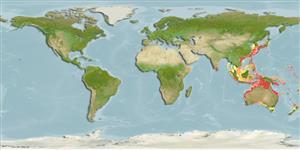Environment: milieu / climate zone / depth range / distribution range
Ökologie
seewasser demersal; standorttreu. Temperate
Western Pacific: Taiwan and Japan to Western Australia and New South Wales.
Size / Gewicht / Alter
Maturity: Lm ? range ? - ? cm
Max length : 60.0 cm TL Männchen/unbestimmt; (Ref. 559)
Vomer without a median series of enlarged fangs; caudal fin reduced, tip of tail blunt; anus behind midlength.
Found on the continental shelf, in less than 100 m depth. Poorly known and included in the Muraenesocidae provisionally, pending further study (Ref. 9830).
Life cycle and mating behavior
Maturities | Fortpflanzung | Spawnings | Egg(s) | Fecundities | Larven
Paxton, J.R., D.F. Hoese, G.R. Allen and J.E. Hanley, 1989. Pisces. Petromyzontidae to Carangidae. Zoological Catalogue of Australia, Vol. 7. Australian Government Publishing Service, Canberra, 665 p. (Ref. 7300)
IUCN Rote Liste Status (Ref. 130435)
Bedrohung für Menschen
Harmless
Nutzung durch Menschen
Fischereien: nicht kommerziell
Tools
Zusatzinformationen
Download XML
Internet Quellen
Estimates based on models
Preferred temperature (Ref.
123201): 19.3 - 28.7, mean 27.2 °C (based on 680 cells).
Phylogenetic diversity index (Ref.
82804): PD
50 = 1.0000 [Uniqueness, from 0.5 = low to 2.0 = high].
Bayesian length-weight: a=0.00132 (0.00056 - 0.00309), b=2.93 (2.73 - 3.13), in cm total length, based on LWR estimates for this (Sub)family-body shape (Ref.
93245).
Trophic level (Ref.
69278): 3.8 ±0.6 se; based on size and trophs of closest relatives
Widerstandsfähigkeit (Ref.
120179): mittel, Verdopplung der Population dauert 1,4 - 4,4 Jahre. (Preliminary K or Fecundity.).
Fishing Vulnerability (Ref.
59153): Moderate vulnerability (44 of 100).
Nutrients (Ref.
124155): Calcium = 30.7 [19.3, 54.0] mg/100g; Iron = 0.323 [0.194, 0.524] mg/100g; Protein = 18 [16, 20] %; Omega3 = 0.595 [0.285, 1.517] g/100g; Selenium = 21.9 [12.1, 40.4] μg/100g; VitaminA = 12.6 [3.4, 44.4] μg/100g; Zinc = 0.471 [0.349, 0.656] mg/100g (wet weight);
